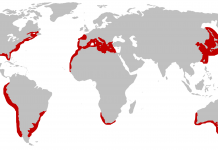Do you have any idea why are great white sharks endangered in their natural habitat? To begin with, the great whites are not endangered species anymore. The IUCN Red List has now listed them as vulnerable. However, that doesn’t mean its survival is not at stake because certain illegal activities of humans are driving them to become endangered.
Why are Great White Sharks Endangered?
For years, the white sharks have been subject to a number of man-made attacks and most of these are merely for fun. This is in large part due to its unsavory reputation which was needlessly aired by entertainment media.
Humans usually hunt this species to trade its teeth and jaws in particular, as trophy-hunting. It is also killed for sports-fishing and infrequently they also fall victim to human’s diet. One of the problems with this species is that when it is ensnared, the chances that it may live on are reduced probably because of trauma. For most of the times, their curious nature drives them near the fishermen’s boats and thus posing grave danger to themselves. This is one of the major reasons why this species is getting caught up and killed.
Moreover, some fishers think the presence of this species cause great obstacle to their fisheries so they do not show mercy to the shark whenever it turns up. On the contrary, others believe the white shark plays a vital role and it is actually helpful in fisheries because it devours pinniped that eats their catches. In spite of this, the most irksome fact is that it readily falls prey to some of the bizarre commercial activities of humans like the curio trade, trade of public aquarium, sports fisheries and the oriental shark-fin trade.
The killing of a few individuals (whether due to habitat degradation or bycatch) has had a far-reaching impact on its population in a particular locality. It is also observed that this species cannot carry on when kept in big public oceanaria. These are some of the causes behind why are great white sharks endangered.
As for trade of its different parts, the fisheries seek out the jaws, teeth and fins of the white shark. Its teeth are used as curios or trophies. It is observed that the price of each tooth of this shark is as high as US$ 800 in South Africa while the jaws cost as much as US$ 50,000. Its different parts are displayed as curios yielding higher revenues. A pair of fin may cost as high as US$ 1,000. These shark-products earn higher prices for the fishers and thus motivate them to do illegal trade of its parts.
Sources:
Fergusson, I., Compagno, L.J.V. & Marks, M. 2009. Carcharodon carcharias. The IUCN Red List of Threatened Species 2009: e.T3855A10133872.







